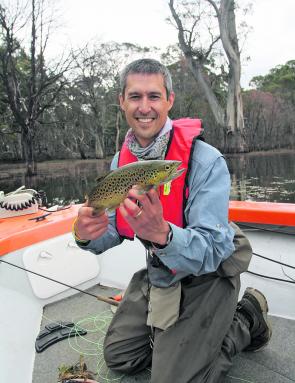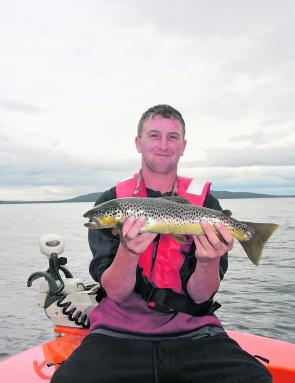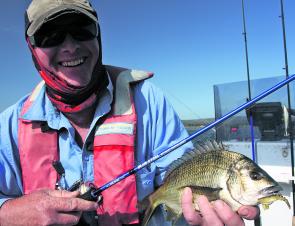While the days are becoming shorter and daylight savings has finished, the fishing in the Apple Isle is far from fading.
The brown trout season is in its final month, and while this will often mean cold conditions, it also spells some of the most wonderful cool autumn days you will ever experience.
The highlands is now pretty much all about pre-spawn brown trout and fit and bright rainbow trout. I’ve never subscribed to the theory that trout feed up in the lead in to the spawning season – trout eat as much as they can at any stage of the season!
At this end of the season most trout are focussed on scud and shrimp, especially in Arthurs Lake. Warm and calm days will see beetles and jassids take to the wing and plop on the water, but the main game is beneath the surface.
Great Lake’s trout do love a surface feed as autumn draws the curtain on another warm season. Midges and beetles ate the prime aim, but the much-loved jassids will always get trout looking to the surface. Warm (relatively speaking) north winds will push terrestrial insects off the trees along the northern edges of the lake between Breona and Cramps Bay, and slicks and foam lines should always be keenly explored by the dry fly fisher.
When the weather gets dirty then it’s time to pull out the soft plastics and hammer the rocky shores from the boat. Brown trout at this time of year are very toey as their hormones prepare for spawning, so lures with a flash of yellow or orange are the best bet. The new Strike Tiger T Tails in black and gold have the track record so far fished on a 1/8oz jig.
When the weather gets dirty then fishing deep wet flies and cast lures around Tumble Down and Cow Paddock are as reliable as you will find. Even though Arthurs has been tarred with a small fish reputation this year, April will see the bigger fish step up to the plate.
If the weather turns easterly and bright then head to Flemings Bay and look for gum beetles and jassids – this is a very reliable spot for them.
Now that the mainland influx has pretty much passed, this area is well worth visiting again. While many anglers abandon this area after March, some of the best fishing of the season awaits. The window of opportunity is smaller, but often bears a heavier fruit. Look for lakes that cope with the lower levels better, like Lake Ada, Augusta and Double Lagoon.
The Pine has had a busy year – I drove past in February and counted over 30 boats – not my idea of fun! On most days in April you will have the lake to yourself (pretty much) and tailing fish are back on the agenda as the season glides to an end.
Failing that, pulling yellow and black wet flies is great and some solid fish will result.
April is awesome in the salt – the estuary scene is fantastic with pretty much every species on the chew and the offshore sport is really hitting its straps.
Big bluefin tuna are the talk of the town since the first jumbo was caught in late February. Albacore really hadn’t made their presence felt in early March, but fingers are well and truly crossed for an April resurgence.
Striped tuna have been everywhere from the 50m line out, with most boats having their fun before trying to find something more substantial. Yellowfin haven’t been thick, but with the warm current throwing up all sorts of fish including mahi mahi on a semi regular basis anything is possible.
April is widely regarded as the best month for game fishing off St Helens for albacore, yellowfin and striped marlin, so we can only look forward and ignore the recent dearth of big fish.
Eagle Hawk Neck is quite different, with most boats regularly finding SBT on any given day from early March. Given that the prime season extends all the way through to August we could be in for something special indeed.
Inshore bays like Great Oyster Bay have been fishing extremely well for the bread and butter species, such as flathead and calamari. Yellowtail kingfish have been much sought after, and are as elusive as ever.
Across the north coast the schools of bigger salmon seem to have been pursued by some bigger kingfish, with some persistent anglers doing well on a regular basis.
Big schools of jack mackerel are all along the coast, which is inviting all sorts of predators along, and as April progresses we hopefully will see some more captures of kingfish.
Bridport is always worth a look at this time of year as the barracouta move along the coast – snapper and yellowtail kingfish are always on the agenda.
If you had to pick a month for bream on the Derwent, April would be one of the top ones. This year has been pretty dry, so bream are well entrenched in all the shallow stretches of the river.
Shallow running minnow hardbodied lures are the pick of the bunch, but don’t neglect soft plastics around the structure, especially the jetties and piers along the river. Some of the bigger fish will hang around here, and slow fished plastics are sure to bend a rod or two.
The Swan has been reliable all year for bream, but try to avoid big tides, as this seems to suspend huge amounts of annoying weed with the increased flow. Bream on the flats have been much sought after, but the bigger fish always are close to the oyster racks.
Around the mouth is extraordinarily reliable for salmon to 1kg, although most are 500g. As the tide runs out salmon congregate at the mouth, and hardbodied lures like the Zerek Tango Shad in 50mm do very well indeed.
The Scamander River is bream central at any time of year, but April is great as the level rises with the mouth closed over. The bigger bream will start to move to the front of the snags and if the sun is right they can be spotted before they are cast to.
The channel adjacent to the highway bridge is always a chance for a big luderick or two for those who are keen.
The surf beach from Scamander to Beaumaris is prime at this time of year for some good salmon in the surf with the odd gummy shark at night.
Georges Bay is the bay that simply gets better and better. Many anglers catch 10 species in a day, and with April being a great crossover month that species tally can grow.
King George whiting are still the flavour of the month, but they seem to be getting smaller as their population grows. The same can’t be said for silver trevally as these monsters are getting bigger and bigger. Deep fishing around the red channel markers with soft plastics is well worth the time.
Bigger Australian salmon are always a chance in Moulting Bay, and keep an eye out for some kingfish around the schools of smaller salmon.
Bream on the flats are as thick as ever, but weed can be annoying for those casting hardbodied lures. If the weed gets bad just change tack and go hunt something different.
The Tamar seems to be normal – good one day and inexplicably difficult the next. Snapper have been making their mark in some anglers’ bags, but trying to pin down some exact locations is as difficult as ever.
The channel from Shag Rock down past the Maritime College Boat seems to a good spot to start, and the areas around the Batman Bridge are very productive for those in the know.
Most successful anglers I’ve spoken to simply sound around looking for arches on drop-offs – with the change of tide being the best time. Apart from that – good luck!
As always, for the most up to date information, head to your local tackle store, they will have their finger on the pulse.
Reads: 2771
Calamari on the east coast are very reliable in April – bright green jigs are the go and look for the patches of weed amongst reef or sand.

Anchoring up and waiting for a bite – snapper have been the focus of many east coast anglers this season.

Chase those game fish – the Hazards makes a nice back drop while chasing something big.

Trout are prime this year in Arthurs Lake, John Clark snitched with fat little fellow from a shallow bay.

Trout may be a tad smaller this year in Arthurs, but they are in awesome condition.

Bream are looking for hardbodied lures as the tide drops. This Zerek Shrimp was hammered by this keen little fellow.




